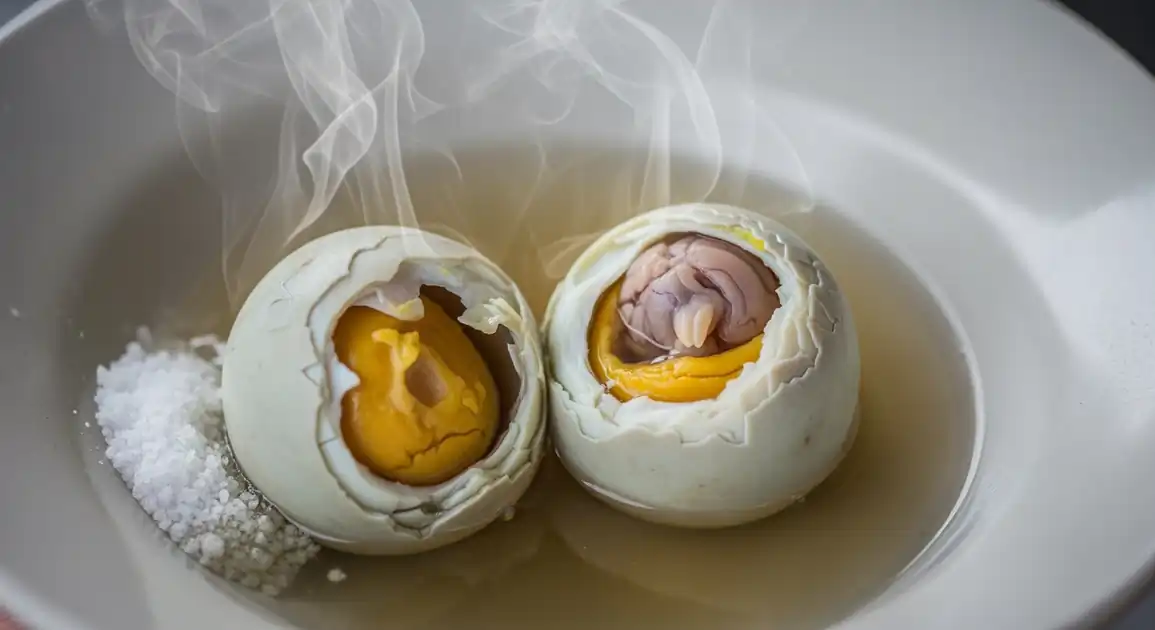Balut in Philippines: A Complete Food Lover's Guide
Balut

Understanding This Dish: An Introduction
Balut is a quintessential Filipino street food, consisting of a fertilized duck egg incubated for 14-21 days, then boiled or steamed and eaten warm directly from the shell. It's known for its distinct components: a savory broth ('sabaw'), a rich yolk ('pula'), and the developing embryo ('sisiw'). Often seasoned with salt or spiced vinegar, Balut is a unique culinary experience deeply embedded in Filipino culture.
How It Is Traditionally Made
Selected fertilized duck eggs are incubated at a controlled temperature and humidity for a specific period (commonly 16-19 days). This allows the embryo to develop to the desired stage. After incubation, the eggs are carefully boiled or steamed until fully cooked. Maintaining the correct incubation time and cooking process is crucial for the final texture and taste. Balut is traditionally served warm to preserve its flavor and safety.
Key Ingredients of Balut (Fertilized Duck Egg)
Fertilized Duck Egg
The core of Balut, typically incubated for 16-19 days. The incubation period is crucial as it determines the development stage of the embryo, influencing texture and flavor.
Quality indicator: Look for eggs from reputable vendors who can specify the incubation age, ensuring consistent quality and desired development.
Broth (Sabaw)
The clear, savory liquid found within the egg, which is the first part consumed. It's naturally formed during the incubation and cooking process, offering a rich, umami flavor.
Quality indicator: The broth should be clear and warm, indicating proper cooking and freshness. Avoid cloudy or cold broth.
Yolk (Pula)
The rich, creamy yellow part of the egg, similar to a hard-boiled egg yolk but often softer and more intensely flavored due to the incubation.
Quality indicator: The yolk should be vibrant yellow and have a smooth, creamy texture, not dry or crumbly.
Classic Pairings for Balut (Fertilized Duck Egg)
Rock Salt
condiment
A simple sprinkle of rock salt enhances the savory notes of the Balut, especially the broth and yolk, providing a classic, clean seasoning that complements its rich flavor.
Spiced Vinegar (Suka)
condiment
Often a mixture of cane vinegar with chilies, garlic, and onions, this provides a tangy, spicy counterpoint that cuts through the richness of the egg and embryo, balancing the flavors.
From Humble Origins: A Brief History
While the exact origins are debated, with potential influences from Chinese traders ('Maodan'), Balut has become intrinsically Filipino. It gained popularity as an affordable, protein-rich snack, especially sold by night vendors. It's culturally regarded by some as an aphrodisiac and energy booster. Today, it remains a ubiquitous street food and a symbol of Filipino culinary identity, often presented as a challenge to adventurous visitors.
Local Balut (Fertilized Duck Egg) Variations in Philippines
Balut (Standard 18-day)
The most common type, with a moderately developed embryo.
Balut Mamatong / Balut sa Puti (16-17 day)
Younger egg, less developed embryo, often preferred by some for milder flavor/texture. 'Sa Puti' refers to being wrapped in white cloth, a traditional belief.
Older Balut (20+ day)
Larger, more developed embryo with noticeable features (bones, feathers). Stronger flavor.
Penoy
Related snack; incubated egg where embryo failed to develop. Contains yolk and albumen, no broth or embryo. Often sold alongside Balut.
Adobong Balut
Cooked Balut (often shelled) simmered in Filipino adobo sauce (vinegar, soy sauce, garlic, peppercorns). More a restaurant/home dish than street food.
Universal Quality Indicators
What to Look For
-
Egg feels distinctly warm or hot to touch
This indicates the balut has been recently cooked and maintained at an optimal temperature, preserving its quality and freshness.
-
Vendor keeps eggs in an insulated container (e.g., cloth-lined basket, styrofoam box)
This practice helps maintain the crucial warm temperature, which is key for preserving the balut's quality and optimal flavor.
-
Intact, uncracked shell before purchase
An intact shell is a sign of proper handling and helps maintain the egg's integrity and freshness. Minor cracks from handling are distinct from pre-existing damage.
-
Clean condiment dispensers (salt shaker, vinegar bottle)
Observe if the vendor maintains clean condiment containers, as this often reflects their overall attention to hygiene and food handling practices.
-
Vendor has regular local customers
Often indicates reliability and trusted quality within the community.
What to avoid
-
Cold or room temperature Balut
Balut is best enjoyed warm or hot to ensure optimal flavor and texture. Cold balut indicates it may not be fresh.
-
Eggs with significant cracks before buying
Significant cracks can compromise the egg's integrity and freshness, indicating it may not have been handled with care.
-
Visibly dirty vendor setup or handling practices
Observe the vendor's overall cleanliness, including surfaces and hands, as this reflects their attention to quality and proper food handling.
-
Balut sold in questionable locations or by unknown vendors
Stick to vendors in busy areas or those recommended by locals if possible.
Explore Balut (Fertilized Duck Egg) in Detail: City Guides
Discover where to find the best Balut (Fertilized Duck Egg) and learn local tips in these cities:
Dietary Information
Dietary Information
Important Note for Travelers: Your safety is our priority. Below are the common allergens associated with the traditional preparation of this dish. However, recipes and ingredients can vary significantly between establishments. Always confirm all ingredients directly with the food vendor before ordering, especially if you have a severe allergy.
Potential Allergens
Dietary Suitability
How to Order Balut (Fertilized Duck Egg)
Frequently Asked Questions about Balut (Fertilized Duck Egg)
What exactly is Balut?
Balut is a popular Filipino street food made from a fertilized duck egg (or sometimes chicken egg) that has been incubated for a period, typically 14 to 21 days, depending on preference. The egg is then boiled or steamed. Inside, you'll find the broth (sabaw), the yolk (pula), and the developing embryo (sisiw).
How do you eat Balut?
First, crack the wider end of the warm egg carefully. Make a small opening and sip the savory broth ('sabaw'). Then, peel more of the shell. Season the contents (yolk and embryo) with salt and/or spiced vinegar ('suka'). Eat the yolk and the embryo. Some people discard the hard, white albumen part ('bato').
Is Balut a good choice for tourists?
Generally, yes, if sourced correctly. Choose vendors who keep the balut warm/hot (indicating it's well-cooked and fresh). Ensure the shell isn't cracked. Use the provided condiments (salt, vinegar). For first-timers, the appearance and texture can be challenging. Start with a younger egg (e.g., 16 days) if possible.
What does Balut taste like?
The broth is rich and savory, similar to a concentrated soup. The yolk is creamy, like a rich egg yolk. The embryo's taste is mild; its texture varies with age – younger embryos are tender, while older ones (18+ days) might have developing bones and feathers, offering a slight crunch. The white albumen ('bato') can be very hard.
What's the difference between Balut and Penoy?
Both are types of incubated duck eggs sold by vendors. Balut contains a developing embryo. Penoy is an egg where the embryo did not develop properly or was unfertilized; it has no distinct embryo structure, just a mixture of yolk and albumen, and lacks the broth. Penoy has a stronger, sulphurous smell and taste compared to Balut.
How do I choose a good Balut?
Look for vendors keeping the eggs consistently warm in an insulated basket or pot. The egg should feel warm to the touch and the shell should be intact (no cracks). Reputable vendors often have regular customers. You can sometimes ask for the age (e.g., '16 days' is less developed, '18 days' is more common and developed).
Are there different 'ages' of Balut?
Yes, the main difference lies in the incubation period. 'Balut mamatong' (16-17 days) has a smaller, less developed embryo. Standard balut (18-19 days) has a more noticeable embryo. Older balut (20+ days) has a much larger embryo with more developed features. Preferences vary among Filipinos.
Expert How-To Guides about Balut (Fertilized Duck Egg)
How to Eat Balut Like a Local (First Timer's Guide)
This step-by-step guide will empower you to confidently try Balut for the first time, ensuring an authentic and enjoyable culinary experience.
- Find a reputable vendor selling warm Balut.
- Hold the egg with the wider end up. Gently tap and peel a small hole in the top.
- Carefully sip the warm, savory broth ('sabaw').
- Add a pinch of salt or a splash of spiced vinegar ('suka') into the opening if desired.
- Peel away more of the shell to expose the yolk and embryo.
- Eat the yolk and the embryo. Use salt/vinegar to taste.
- The hard white part ('bato') is often discarded, but edible if you wish.
- Wash hands or use sanitizer afterwards.
How to Spot a Good Balut Vendor ('Magbabalut')
Learn practical tips for identifying reputable vendors who sell fresh, high-quality Balut, ensuring a positive and authentic street food experience.
- Listen for the distinct call: Vendors often shout 'Baluuuut!' or 'Baluuut, Penoy!'.
- Check the temperature: Eggs should be kept warm, usually in a cloth-lined basket or insulated container. Avoid cold eggs.
- Observe cleanliness: The vendor's hands, container, and condiment dispensers should look reasonably clean.
- Look for steady customers: Locals buying regularly is a good sign of quality and trustworthiness.
- Check shell integrity: Eggs should be intact without significant cracks before you buy.
Understanding Balut 'Age' (16 vs 18+ Days)
Choose the Balut experience you prefer by knowing the difference incubation time makes.
- 16-17 Days ('Mamatong'): Embryo is smaller, less defined. Bones and feathers are undeveloped. Broth and yolk are prominent. Often preferred by beginners.
- 18-19 Days (Standard): Most common type. Embryo is more developed and recognizable. Small bones might be forming, offering a slight textural difference. Good balance of broth, yolk, and embryo.
- 20+ Days: Embryo is significantly larger and more developed, with noticeable bones, beak, and feathers. Stronger flavor. Preferred by some connoisseurs, but potentially more challenging for newcomers.
Our Commitment to Quality
At Tasteplorers, our mission is to provide the most accurate and useful travel information in the world. To achieve this, all content on this site is created through our unique editorial framework. We utilize leading AI research tools, guided by our proprietary prompts, and a multi-stage validation process. This entire system is overseen by our editorial team to ensure everything we publish meets our high standards for accuracy, cultural nuance, and practical value for travelers.
Learn more about our Editorial Process and our Mission.
Countries
Explore regions
Europe
Discover Europe's diverse culinary landscape, from Mediterranean flavors to hearty Alpine fare. Learn to navigate markets, decode menus, and eat like a local.
Latin America & Caribbean
Discover the vibrant cuisines of Latin America & the Caribbean. Our expert guide covers everything from Mexican street food to Peruvian ceviche and market tips.
Oceania
Explore Oceania's diverse food scene. Learn about Polynesian earth ovens, Fijian feasts, and the vibrant café culture of Australia and New Zealand.
Southeast Asia
Explore Southeast Asia's diverse food cultures from Thailand to Vietnam. Get expert tips on navigating spice levels, choosing quality vendors, and understanding the rich traditions of the region.








